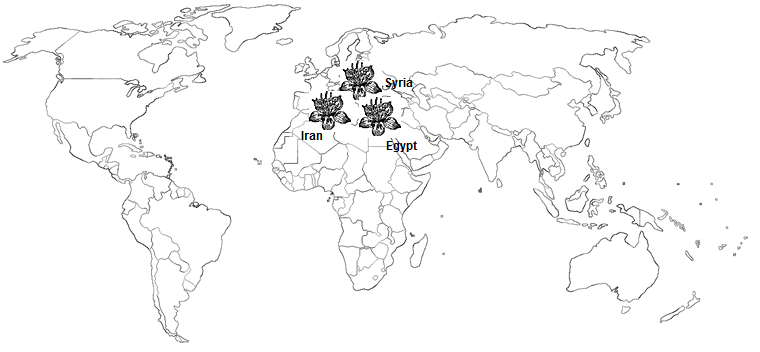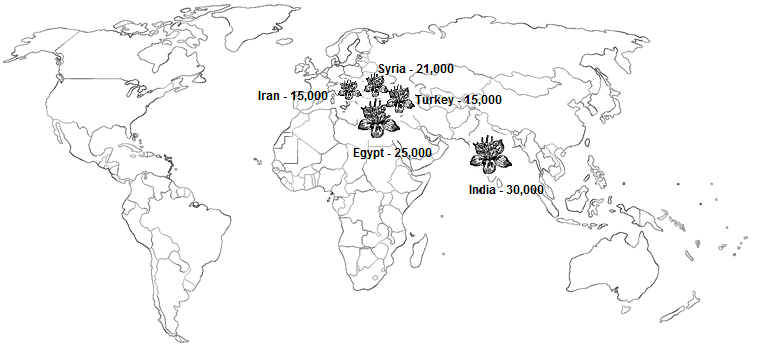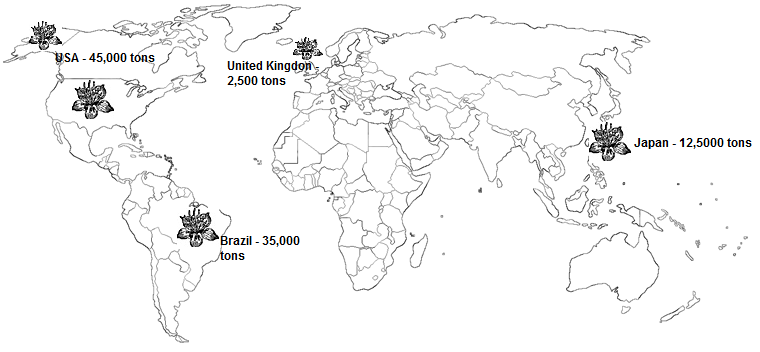The Oriental culture has always been a closed book for the rest of the world. However, it is not only the mystery, but also the specific charm and exotics that catch the attention of the Western people and make them explore the wonders of the East. The Eastern cuisine is no exception, which makes a great case for checking on some of its most exotic elements.
Even though the Eastern cuisine has been unknown to most of the Western culture for centuries, the plant called cumin, or jeera, has been exported from the Eastern countries to the West for several centuries, making the world taste the Oriental cuisine and get a touch of exotics with a single taste of the exotic plant known as jeera, or cumin.
Before going any further, it is necessary to introduce the subject matter to the audience. Though no longer something from the other universe, cumin is still a pretty exotic plant and rather original species for most of the European and American continents, cumin is known among botanists.
Belonging to the family of apiaceae, cumin shares the typical features of the plants of the given group. According to Rita, Aninda and Animesh, Cuminum Cyminum L. (Family: Umbelliferae, common name – Cumin, Safad Jira, Zeera) is an important seed spices of commercial importance (202). It is also quite peculiar that the plant is used not only as spices for Asian cuisine, but also as a raw material for medicine:
The annual herb (seeds and essential oil) possesses potential therapeutic uses (antibacterial activity against Pseudomonas aeruginosa, antioxidant, anti-inflammatory, antidiabetic, anticancerous among others) including Ayurvedic medicine (dyspepsia, diarrhea, jaundice, also considered stimulant, carminative, stomachic, astringent, etc.). (Rita, Aninda and Animesh 202)
Therefore, the plant is known not only for its palatability, but also for the effect it has on people having certain diseases. However, for the given research, the focus is going to be on cumin as a sort of spices. A unique and really peculiar object for a study, cumin is worth taking a closer look at.
Diving deeper into the history of cumin and its origin, it is quite peculiar to note that the people who started the tradition of adding cumin to their dishes, surprisingly enough, were not the residents of the East, as it would be most logical to suggest.
Another group of Mediterranean residents, the population of the Ancient Greece were the first people to use the plant which had such fabulous smell as a flavor and taste enhancer for their dishes. Unfortunately, it is practically impossible nowadays to find out which dish was the first to contain a pinch of jeera in it; however, it is a historical fact that the Ancient Greeks were the first people to discover the delightful taste of cumin:
The near magical properties of Cumin have been known to mankind since ancient times. Native Syria where it thrives in the hot and arid lands it was known to Turkey, Greece and found its way to Spain from where the word cumin passed on to Western Europe and the English language. (Spice Encyclopedia para.13)
Therefore, it can be considered that the Ancient Greeks were the first people to taste cumin. However, the given hypothesis seems rather questionable, since the plant comes from Syria, which means that the Syrians were supposed to be the first people to discover the properties of jeera.
It could be assumed, though, that the medical specifics of the plant were the focus of the Syrians, while the taste was not considered anything special. Anyway, despite the obscure history of discovery, cumin has integrated into the lives of millions of people in the modern world, which means that its first discovery and application are curious, yet not quite relevant facts.
To start with, it will be necessary to take a look at the countries which cumin has originated from. As one must have thought, the plant was cultivated in the Asian region, which is practically why the plant is popular in the East so much. As a matter of fact, it can even be considered that cumin, or jeera, is a specific symbol of the Asian countries.
However, it would be better to say that jeera could have been the symbol of Mediterranean countries; according to what trustworthy sources say, this is where the plant came from. Taking a closer look at the map of jeera origin, one can see distinctly that the Mediterranean area is exactly where cumin comes from:

Despite the fact that the Mediterranean area includes not only Syria, Iran and Turkey, but also a number of European countries like Italy and Greece, it is rather weird that cumin is not cultivated in the latter.
Perhaps, the plant has become so closely intertwined with the Easter culture over the centuries that Italy, Greece and other Mediterranean countries do not consider cultivating cumin as an option. Anyway, judging by the evidence offered in the Figure 1, it can be suggested that Mediterranean area, especially Iran and Syria, were the epicenter of cumin growth.
Considering the above-mentioned information about the countries where cumin was found first, one can possibly guess the sources in which cumin was first mentioned, as well as what nation and at what time period discovered the given spices.
As one must have guessed, the history of cumin discovery and first attempts at using it root deep into the history of the humankind and start since the beginning of the era of Anno Domini. According to Boning, Bible was the book which mentioned cumin first as a plant used in cooking.
Boning claims that “It has been employed as a spice since biblical times” (79). As a matter of fact, cumin gets even its own mentioning in the Bible. As Hoffman and Hoffman explain, cumin is “another spice that predates Biblical times. In Matthew 23, Jesus says: … ye pay tithe of Mint and Anise and Cumin’” (18).
Therefore, it can be considered that, in the course of its long and proud history, cumin was best known for its taste and the way it could be used in cooking.
Nevertheless, even with all its incredibly delicious taste and the flavor enhancing abilities, cumin has been unknown to a great chunk of the Western population for quite long, and it was not until the era of the Spanish explorers that cumin became famous all over the world. According to Boning, “The Spanish introduced cumin to the Western Hemisphere” (79), which the humankind will always be grateful to Spain for.
However, despite the fact that cumin originated in the Mediterranean area, it is produced in a number of countries, some of which do not all under the category of Mediterranean ones.
Taking a closer look at the places where cumin is produced, one can possibly understand the true value of the plant and figure out whether cumin is a significant element of the total range of products which are exported from Asian countries into the Western countries.
It is essential to emphasize that, even though cumin originates from the Mediterranean area, it could have been easily transported to any other place of the world and, therefore, cultivated in a completely different place quite successfully.
Of course, such factors of cumin growth as climate, especially humidity and temperature must be taken into account when analyzing tits places of cultivation, yet the fact that cumin could be spread all over the world cannot be denied.

Analyzing the evidence sown in the Figure 2, one can come to the conclusion that cumin is produced nowadays mostly in the countries of the Mediterranean area, i.e., the area where the plant actually comes from. However, a second glance at the map shows that cumin is also exported from India, which is quite peculiar given the fact that India was not the country where the plant has come from.
There can be various explanations as for the above-mentioned fact. Among the most obvious ones the geographical location seems legit enough. Indeed, it can be considered that the Indian climate is quite close to the Mediterranean one, which makes India a perfect place to grow cumin in, with the annual production rates making 30,000 tons of cumin (Cumin Mandi Rates para. 1).
The latter is basically predetermined by the specifics of the plant. According to Boning, “Cumin is adaptable and relatively easy to gro. It performs best in the sun and prefers a dry, Mediterranean-like climate. It is fairly drought tolerant” (Boning 79), which explains why cumin cannot be cultivated in such countries as Great Britain with its mostly rainy and windy weather, and South America with its tropical climate.
Another peculiar change of location is Turkey. Even though cumin was not originally grown there, it is still quite understood what made the population of the country start growing the plant. With its specific taste, it completed the Turkish cuisine and seemed its integral part.
Finally, the issue of consumption of cumin must be touched upon. It is quite understood that the population of the countries which grow cumin uses it in their daily cooking and considers the spices a part and parcel of their cuisine; however, when it comes to the rest of the world, it seems rather doubtful that a great chunk of the population would accept something that distinct and different from the Western culture as cumin.
However, weirdly enough, the aforementioned assumption has proven completely wrong; as it turns out, there are a number of Western countries and cultures which use cumin in their cuisine. Taking a glance at the world’s major places of cumin consumption, one can easily evaluate the importance of the given plant.

As the map shows, the main spots of cumin consumption are Japan, Brazil, the United Kingdom and the United States. Analyzing the obtained information, one must say that the results offered in the map are rather surprising.
Indeed, if the consumption of cumin in Japan can be easily explained by the fact that Japan is an eastern country and, therefore, must have been influenced by other eastern culinary traditions, the fact that cumin is a traditional spices in, say, Great Britain, is rather surprising.
Moreover, such a country as Brazil, which is so detached from the Asian continent that it must have literally nothing in common with the latter, is one of the world’s greatest consumers of cumin, which is another surprise. However, it is worth noting that the situation in the USA, where cumin has obviously become an integral part of culinary, is not as much surprising.
Indeed, being a place where one can find the representatives of literally every other culture, there must be a huge chunk of Asians among immigrants; consequently, in their own diaspora, they use cumin in the process of cooking, which makes the USA one of the world’s leaders in cumin consumption.
Weirdly enough, cumin has become not only a plant used for certain purposes in the Eastern cuisine. Moreover, cumin is even more than simply a symbol of the East. Tightly intertwined with the very spirit of the East, cumin is associated with a number of superstitions. Which is even more important, cumin is nowadays associated with a number of superstitions:
Many superstitions are associated with cumin. A happy life awaited the bride and groom who carried cumin in the wedding ceremony. If the seed was cursed when it was planted, it would produce a wonderful crop. (Hoffman and Hoffman 18)
The above-mentioned signifies that cumin has become the symbol of the East, a part and parcel of the Eastern culture. Although it used to be the element of the Oriental cuisine several decades ago, it seems to have spread all over the world nowadays and is used by literally everyone.
Perhaps, due to its specific flair and exotic origin, cumin has become one of the most easily recognizable elements of the Eastern cuisine and at the same time has settled in the Western culture as well, therefore, creating a cultural paradox.
Among other essential issues concerning cumin, its impact on people’s health and well-being must be mentioned. On the one hand, it might seem that such a seemingly insignificant element of one’s diet as spices can hardly have any tangible effect on one’s health.
On the other hand, it is essential to keep in mind that a human body is a fragile system which is subject even to the least noticeable outside impact. As claim, the idea that spices can have any possible effect on people’s health has been questioned for a considerable amount of time:
The importance of herbs and spices, which have been used as flavour enhancers since ancient times in different cuisines all over the world, is only beginning to surface. Spices as defined by the US Food and Drug Administration are “aromatic vegetable substances, in the whole, broken, or ground form, whose significant function in food is seasoning rather than nutrition (Bhattacharjee and Sengrupta para. 1)
Nevertheless, it can be still suggested that cumin can also possibly have certain impact on the way people’s organisms work. Indeed, if considering the work by Bhattacharjee and Archana, one will be able to make certain that spices in general and cumin in particular do have considerable effect on people’s health.
To its credit, one must admit that the given effect is mostly positive. According to Bhattacharjee and Archana, cumin can be possibly used of cancer prevention:
Results from a study conducted to assess the affect of cumin on experimentally induced forestomach and uterine cervix tumorigenesis in Swiss albino mice showed a significant inhibition of benzo(a)pyrene [B(a)P]-induced stomach tumor burden (tumors per mouse) by cumin.
Cervical carcinoma incidence was also found to be reduced in the cumin treated group compared with the 3-methylcholanthrene (MCA)-treated control group. (Bhattacharjee and Sengrupta para. 5)
Thus, it seems that cumin ha all reasons to become an important element of every single cuisine of the world; with its specific taste and the effect that it has on people’s health, the plant seems to be a truly miraculous creation. No wonder that jeera has entered so many world cuisines. However, to see the full impact of cumin on the world art of culinary, it is necessary to consider several cuisines which have been influenced by cumin most.
One of the most graphic examples of a cuisine shaped by the use of jeera is the one of Latin America. Although taking the entire continent to show the effect of cumin on a certain cuisine should actually be considered a major generalization, in the given case, such generalization is an absolute necessity, since cumin has affected a number of countries in Latin America.
To start with, the given spices have shaped the Mexican cuisine a lot, which Tainer and Greins emphasize: “Cumin, oregano, garlic, onion, coriander, sesame seed, cilantro, and red pepper and to a lesser degree bay leaves, allspice, clove, cinnamon, sesame seed, and anise are all used in Mexican cooking” (Tainer and Greins 224).
However, Mexican cuisine is not the only one which has been inspired greatly by the famous spices. According to Tainer and Greins, such cultures as the Puerto Rican and the Cuban one have also been inspired by jeera when developing their cuisine. A cross between the Spanish and the Mexican cooking, the given cuisines also use jeera as a specific enhancer of taste, making the dish unique.
As Tainer and Greins assure about the Puerto Rican and Cuban cuisines, “The ingredients in both are very similar. Garlic, cumin, oregano, bay leaves, onion, cloves, nutmeg, ginger, thyme, cilantro, cayenne, cinnamon, black pepper, turmeric, and paprika are common spices in Spanish-Caribbean cooking” (Tainer and Greins 224).
Therefore, it is obvious that the world would have lost a lot if the famous plant had not been exported.
Now that every single cook knows what this plant is and how to use it to make the dishes taste even more delicious, it I obvious that with the help of jeera, the world has a chance not only to taste the Oriental cuisine and make the Western dishes more exquisite, but also to explore the Eastern world a little bit better, and perhaps, even to plunge into the depth of the Oriental philosophy, with its specific pace and the specific thoughtful mood which the latter sets one into at once.
Once completely unknown to the rest of the world, cumin nowadays links the East and West, which makes jeera a part of the world history.
Works Cited
Bhattacharjee, Shamee and Archana Sengrupta. “Spices in Cancer Prevention: An Overview.” The Internet Journal of Nutrition and Wellness 7.1 (2009). Web.
Boning, Charles R. Florida’s Best herbs and Spices. Sarasota, FL: Pineapple Press, 2010. Print.
Cumin Mandi Rates 2012. Web.
Rita, Paul, Mandal Aninda and Datta K. Animesh. “Cumin (Cuminum Cyminum L.; Umbelliferae) Cultivation in west Bengal Plains, Kalyani, Nadia.” International research Journal of Pharmacy 3.2 (2012): 202-205.
Spice Encyclopedia 2008. Web.
Tainer, Donna R. and Anthony T. Greins. Spices and Seasonings: A Food Technology Handbook. New York, NY: John Wiley & Sons, 2001. Print.